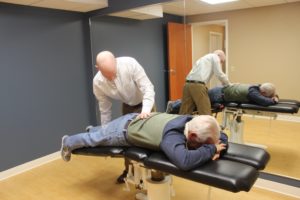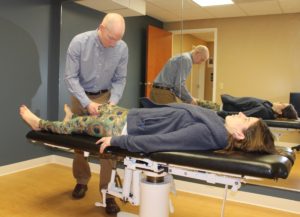Physical Therapy by nature involves physical movements of the patient and/or therapist. This “physical”  approach should include some form of HANDS-ON CARE. This hands-on care may have a broad definition, but includes things like muscle or joint stretching, massage, and active-resisted exercises. One should not be subjected to passive treatments only such as e-stim, ultrasound, ice/heat. Likewise no one should just exercise under supervision of some assistant or tech (that could just as easily be done at home). Why waste time and money for that?
approach should include some form of HANDS-ON CARE. This hands-on care may have a broad definition, but includes things like muscle or joint stretching, massage, and active-resisted exercises. One should not be subjected to passive treatments only such as e-stim, ultrasound, ice/heat. Likewise no one should just exercise under supervision of some assistant or tech (that could just as easily be done at home). Why waste time and money for that?
These hands-on treatments in conjunction with very specifically prescribed exercise are shown to be more beneficial than exercise alone for many conditions. Walker et al 2008 found significant improvement with this approach for those with neck pain. Hokesma et al 2004 and Deyle et al 2005 both found better outcomes for hip and knee arthritis respectively when combining hands-on treatments with exercise vs. exercise alone. These are only 3 of hundreds of articles reporting similar findings.
Now ask yourself, what was your experience with physical therapy? If you did not get this type of care, then unfortunately you did not receive the most up-to-date treatment. Finding a physical therapist should be just like finding a specialist doctor for your orthopedic issue. You want to find one with the experience, credentials, and skills to treat your issue. Not all doctors and therapists have the same skill sets.
If you have been suffering with pain or reduced mobility, wouldn’t it be nice to change that?
Back to the hands-on talk…What do these treatments really add? Well, exercise is great, but often individuals need that little extra to help them experience improvement. See, individuals with knee arthritis for example, may be lacking some motion of their knee, hip, or ankle that they need help to achieve said task. This may not be comfortable, but the end result is improved ease of walking or better stair climbing among others.
A quick example to illustrate this point. A middle-aged man with 10 year history of knee pain. He walks into my exam room with a bent knee (lacking 10 degrees of motion). Because of him walking with a bent knee, his knee pain had increased over the last 3 months. Not to mention his opposite hip started to hurt as well from walking with a limp. We spent the next 4 weeks working aggressively to help him regain his knee motion. Yes, there was some pain along the way. But once his knee was “straight” again, his pain was minimal again. Plus, he decided to put off the knee replacement surgery his orthopedic was pushing. A little pain now helped him avoids months of pain following a major surgery.
exam room with a bent knee (lacking 10 degrees of motion). Because of him walking with a bent knee, his knee pain had increased over the last 3 months. Not to mention his opposite hip started to hurt as well from walking with a limp. We spent the next 4 weeks working aggressively to help him regain his knee motion. Yes, there was some pain along the way. But once his knee was “straight” again, his pain was minimal again. Plus, he decided to put off the knee replacement surgery his orthopedic was pushing. A little pain now helped him avoids months of pain following a major surgery.
This scenario holds true for most regions of the body and many ailments. There is no need to put up with these daily aches and pain without putting up a fight. Do not lose your mobility or independence. Do not let a doctor tell you nothing can be done. Treatment with hands-on care is more successful when addressed early.
If you want more information on conditions treated click HERE or check out the commonly treated conditions tab HERE.
